The entire world is able to access your business the second your website goes live.
You may be surprised to learn that a large segment of your target market lives outside of the United States.
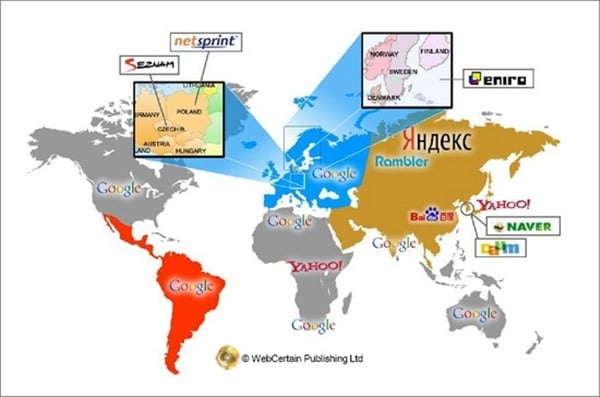
If that’s the case, you’ll need to shift your marketing plan ASAP to target them and make the most profit possible.
But, how are you supposed to adjust your traditional SEO to start attracting international customers?
There is actually a separate branch of SEO dealing specifically with customers from other countries—it’s called international SEO!
SEO fundamentals are pretty much the same whether you’re doing it domestically or internationally, but the big difference is finding what works for some countries and not for others.
Keep scrolling to learn more!
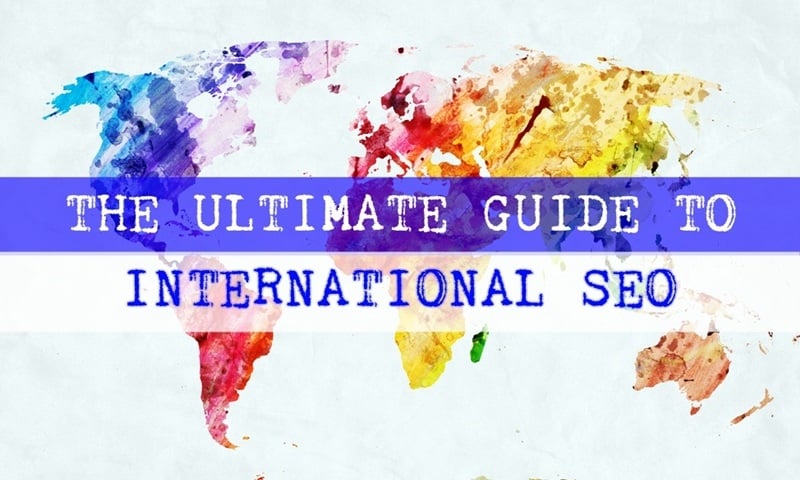
Do I Need International SEO?
Chances are some of your audience will live in other countries. It makes sense if you think about it. The majority of internet users speak a language other than English.
Geotargeting can help you compete on the global market and reach out to countries that are driving eCommerce sales growth, but are you prepared to translate your entire site into different languages, and then optimize these versions for specific SERPs, traffic, and conversions?
You should consider international SEO if:
- You are no longer satisfied with your local operations and want to take your business to the next level.
- Your business has a large worldwide customer base or you are operating in different countries.
- Developing a new web presence for specific countries & languages will result in more traffic & better conversions.
- You have the time and financial means to develop an International SEO plan.
If your business model doesn’t meet any of these conditions it is too early to think about international SEO.
Securing country code top-level domains (ccTLDs) for countries with high potential and creating alerts in your Google Analytics dashboard for international visitors should be enough, for now.
On the other hand, if developing international SEO seems like the best solution for your online presence, based on the conditions mentioned above, it’s time to identify and assess opportunities.
Identifying International SEO Opportunities
Assess your online business model
First and foremost, you have to consider your business model. Here are a few questions that you need to answer:
- How does your business work online?
- What are your online goals?
- How are you delivering your services/products?
- Are your services completely site-based or do you also offer local services?
- Do you have the capacity to deliver products/services globally?
- What are your business constraints?
Understanding the implications of going international from the beginning will save you a lot of time and resources.
Failing to correctly evaluate your business’s strengths and weaknesses may lead to the inability of compensating for international SEO expenses.
Audit the international SEO potential of your site
The next step is to discover if your website has a (potential) global audience by viewing your Google Analytics data.
Like we said above, start off by navigating to Audience and then Location to identify which countries your visitors are coming from.
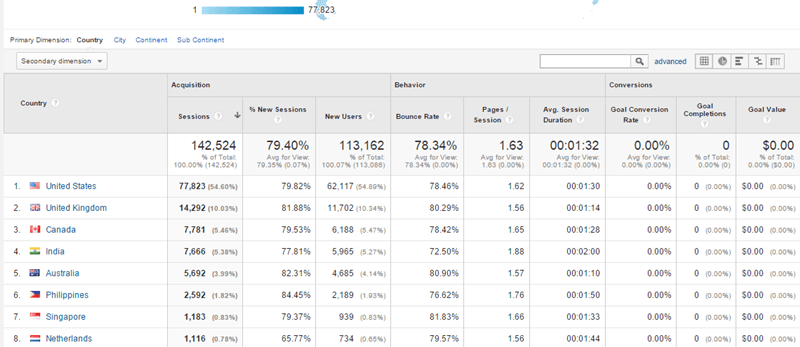
If you want to see visibility for organic search listings simply add “organic traffic” as a second dimension (for multi-regional SEO).
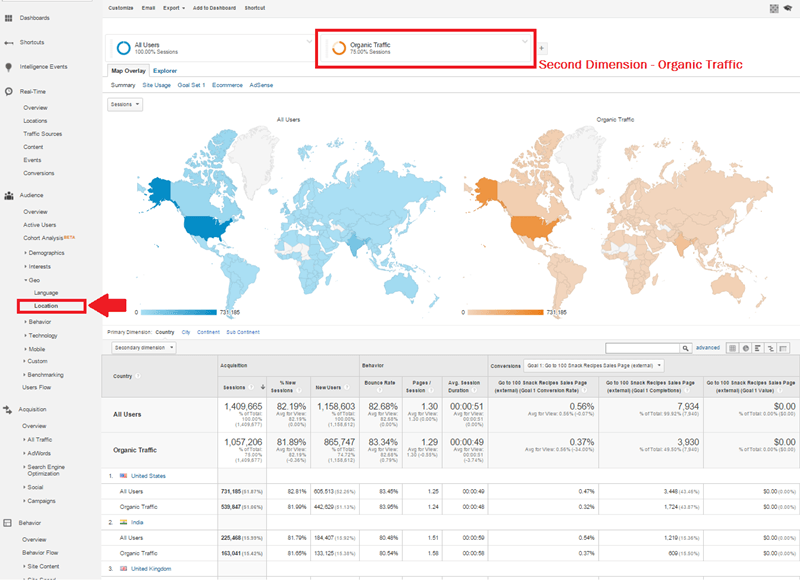
Next, you should check out language information from the Audience -> Overview -> Location report. This will give you a better idea of how you should approach multilingual SEO.

You can dig deeper and check organic traffic sources per language and country by navigating to the Acquisition -> All Traffic -> Channels tab. Click on “Organic Search”, then choose “Source” as your primary dimension.

As you can see, Google Analytics provides all of the information you need to determine whether or not you should invest in international SEO.
Here’s another idea: check the Acquisition -> Search Engine Optimization -> Landing Pages tab and add the “Country” as a secondary dimension to see how many international visitors are landing on your pages.
This information will help you ascertain whether or not your website is ready to take on the international stage.
Don’t focus only on Google
Google may be the most popular worldwide with nearly 90% of the total market share, but data shows certain countries prefer other search engines:
- Yandex is used by many web users in Russia
- Naver has a 64% market share by users in the Republic of Korea
- China’s Baidu has a market share of 72% of users in the country
- Nearly one-quarter of users in Japan prefer Yahoo or Bing
It is extremely important to find out what the most popular search engine is in the country that you are targeting with international SEO.
Not only that but you’ll also need to understand the ins and outs of each search engine. Google has its way of doing things but other search engines may do the complete opposite.
Or there could be important nuances that you’ll need to master to be effective with international SEO.
Research potential international search markets
The final step to identifying international SEO opportunities is conducting research for potential international search markets. Keywords vary from one country to another, even for English-speaking ones.
Therefore, I recommend researching potential organic traffic, search phrases, competitors, and behavior using tools such as SemRush.
Start by evaluating the keywords that you are already ranking for in targeted markets with Semrush.
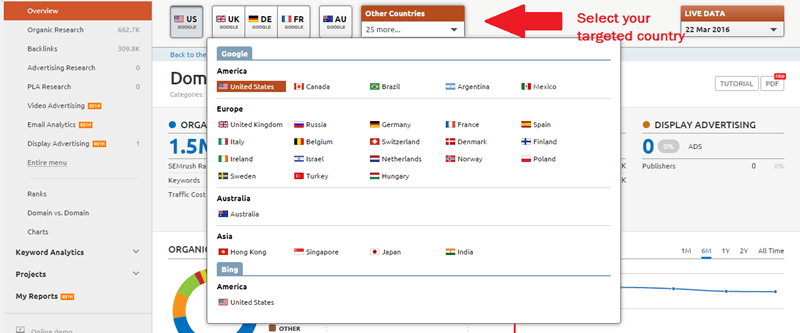
Click on the “Top Organic Keywords” tab to pull out the full list of keywords. Evaluate search volumes, CPCs, keyword difficulty, and competition.
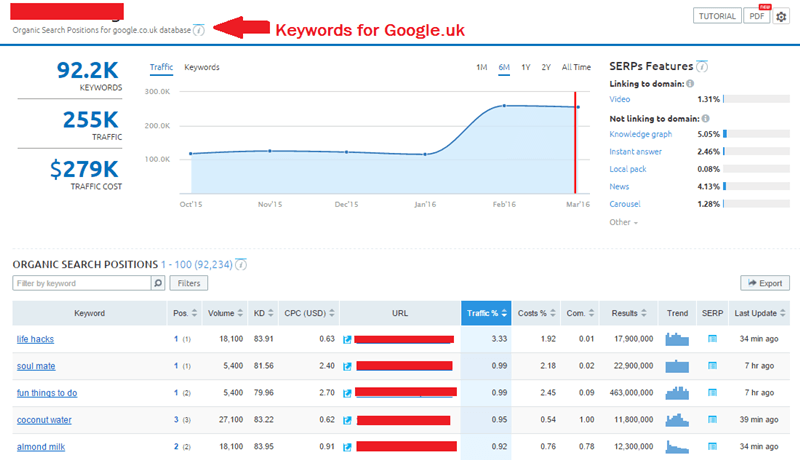
If you are not ranking for any keywords, you can conduct a competitive analysis for similar websites. You can start by using the Semrush Top Websites by country tool.
Copy-paste the domain link to SemRush, select your desired country, and export a list of relevant keywords.
You can also find keyword opportunities using Google’s Keywords tool. Simply select the appropriate location and language to begin your keyword research.
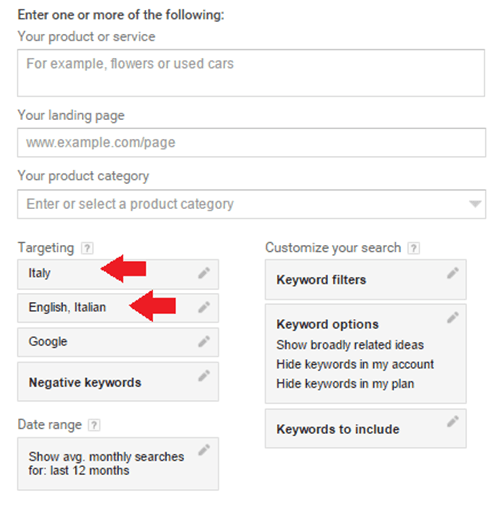
If you are not familiar with the language you will require language support from a native speaker. Here’s how a targeted search will look on Google Keyword Planner:
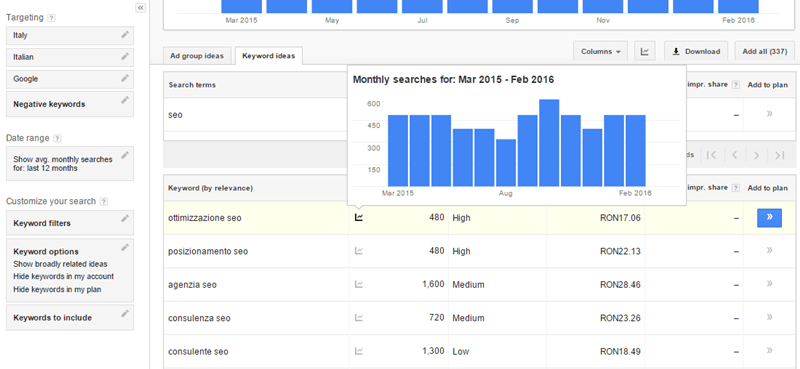
Other Keyword Research Tools:
- Ubersuggest (support for multiple languages)
- Search Metric Essentials
- Google Trends (for top & rising related terms)
- Google’s Global Market Finder (for international opportunities)
Keep in mind that some countries do not use Google, so you will have to identify search phrases using specific indexes, such as the Baidu Index, or Yandex Keywords Stats.
Understanding Keywords & Cultural Differences
It’s never a good idea to assume that other people or countries in the world are searching for the same thing as you.
Just because they’re shopping at your U.S.-based company doesn’t mean they use the same common search terms as someone living in your city.
The keyword research tools we listed above are a great way to narrow down what potential customers are searching for.
Some keywords are commonly searched no matter where you live. But, chances are they won’t apply to your business and you won’t use them to optimize your site.
The terms below rank in the Top 10 Google searches of 2021 both nationally and internationally.
- Youtube
- Amazon
- Google Translate
After that, the list veers off in different directions based on where the user is living. For example, Americans will search for “fox news” while international users will search for “BBC News.”
Users living in Central America, South America, and Europe commonly search for “WhatsApp” while Americans don’t.
So, why is this important to know?
People from other parts of the world prefer WhatsApp as a free text messaging and social media app.
Imagine directing your international SEO and marketing at Facebook or Instagram accounts in Europe but your target audience only uses WhatsApp?
Things wouldn’t end well for you.
Now you can see how important it is to understand these cultural differences as you complete your keyword research.
Many of the keywords you encounter will give you clues like this as to what your international customers are doing.
How to Set Up International Targeting
Now that you have an idea about who your visitors/customers are and what key phrases are working for specific countries, it’s time to identify how you will target them. You have to make your site relevant, not only for non-English speakers but also for English speakers from different countries.
For example, the US and UK may speak the same language, but they behave in fundamentally different ways, expect customer support at different times of day, use different currencies, and are interested in different topics, etc.
This is why your ultimate goal should be to create content that is appropriate to each region & language group.
Google also provides a wealth of resources for businesses to set up multilingual and multi-regional websites.
Domain structure
Depending on whether you’re targeting countries or languages, your website structure will vary. Let’s dive into the details of domain structure options.
There are three choices that you can opt for when setting up your domain architecture, each with its pros and cons.
| URL structure | Advantages | Disadvantages |
| Country Code Top-Level Domain (ccTLD)
e.g. http://.yourdomain.fr |
– ensures better ranking in SERPs for targeted countries.
– emits a strong geo-localization signal. – Easy to market. – Algorithmic updates on other ccTLDs will not affect it. – Reliable method for S.E. to identify the origin of your site. |
– Separate technical support & hosting costs.
– Requires a separate SEO strategy (content, links, etc.) – Requires new links to rank. – May be subjected to censorship. – Crawled separately. |
| Sub-Domain
e.g. fr.yourdomain.com |
– Can use a local IP address.
– Easier to track in Google Analytics. – Easy to manage. – Suitable for small businesses and new entities. – Can have a separate host. |
– Requires a separate SEO strategy.
– Domain value is passed to the sub-domain. – Difficult to set-up country sub-domains for different versions. – Localization optimization is more complicated. |
| Sub-Directory
e.g. http://www.domain.com/fr/en |
– one technical support domain
– easy to execute – inexpensive compared to other solutions – consolidates domain authority |
– weak geo-localization signals
– difficult to maintain country directory for different versions – affected by google penalties on the domain – does not use a specific IP address for different sub-directories |
Country Code Top-Level Domain (ccTLD)
e.g. http://.yourdomain.fr
- Ensures better ranking in SERPs for targeted countries
- emits a strong geo-localization signal
- Easy to market
- Algorithmic updates on other ccTLDs will not affect it
- Reliable method for S.E. to identify the origin of your site
- Separate technical support & hosting costs
- Requires a separate SEO strategy (content, links, etc.)
- Requires new links to rank
- May be subjected to censorship
- Crawled separately
Sub-Domain
e.g. fr.yourdomain.com
- Can use a local IP address
- Easier to track in Google Analytics
- Easy to manage
- Suitable for small businesses and new entities
- Can have a separate host
- Requires a separate SEO strategy
- Domain value is passed to the sub-domain
- Difficult to set up country subdomains for different versions
- Localization optimization is more complicated
Sub-Directory
e.g. http://www.domain.com/fr/en
- One technical support domain
- Easy to execute
- Inexpensive compared to other solutions
- Consolidates domain authority
- Weak geo-localization signals
- Difficult to maintain a country directory for different versions
- Affected by google penalties on the domain
- Does not use a specific IP address for different sub-directories
Language targeting
You should go for a language-targeted approach when the location of your audience does not represent a factor that can influence services/products, content, and website goals.
Websites can start with a language-targeted approach and move towards a country-targeted approach as they identify enough activity from a specific country.
Sub-directory
Enable the main language on your root domain and set additional languages as sub-directories. For example, French can be your primary language but you can also include Italian and German.
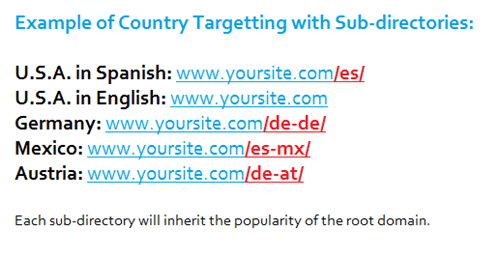
This is one of the easiest and most effective solutions for language targeting. Because it inherits the properties of the root domain, your SEO efforts won’t have to be doubled on the sub-directory.
Sub-domains
Set the main language as the www domain, and additional languages as sub-domains. This strategy is effective for a large number of pages.
Although this solution is better for indexing a large number of pages it also requires separate link-building & SEO efforts.
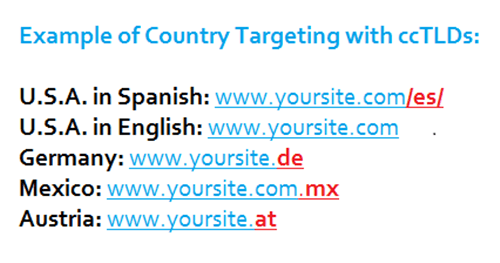
Country Targeting
Your goal with country-targeting is to reach out to the right audience by creating specific versions of your site for different countries.
Google has made it clear that they use ccTLD to determine geotargeting. If you have the technical & financial resources to set up this type of domain structure it will be worth the investment.
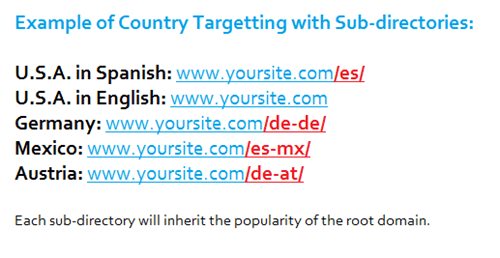
Sub-domain
Enable your primary country in the domain root, then add additional countries as sub-domains. Each sub-domain must be optimized & promoted separately.
Example:
http://www.casacol.co/ – Main version of the site
http://en.casacol.co/ – English version of the site
Sub-directory
The main country appears as the sub-domain and additional countries are created as subdirectories. This solution requires additional geo-localization efforts.
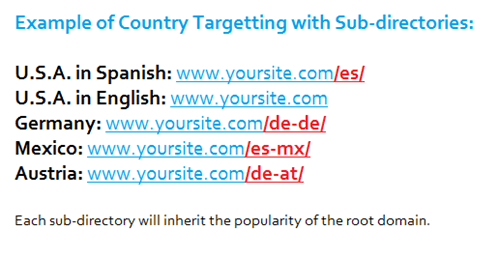
Planning your International SEO Strategy
Translation
Most translation tools are inaccurate and confusing. If you’ve ever read translated spam comments you probably understand what I’m talking about.
How likely are you to trust a website with clunky English and odd use of language? Chances are you’d think they were trying to rip you off.
Professional translators aren’t only masters of words. They understand the country’s local culture and the language’s nuances.
This is extremely important for customer-centric businesses and is part of SEO best practices.
Hreflang mark-up
The hreflang tag (rel=”alternate” hreflang=”x”) is used to tell search engines like Google or Yandex, which language/location you are using on a specific page. The use of hreflang helps you avoid country or language misalignment issues in SERPs.
These tags should always be included in the header area of your site’s HTML code (in the HTTP header) or specified in the XML sitemap (more info here).
Here’s what a hreflang annotation looks like:
<link rel=”alternate” href=http://yoursite.com hreflang=”en-us”/>
Suggested Tool: hreflang tags generator
Important!
Hreflang tags must be added to all your pages, within the page grouping.
The last thing you want is penalties for duplicate content so consider using canonical tags along with your hreflang tags.
On-page SEO
Your goal with international on-site SEO is to optimize your pages so that it is easier for search engines to geo-locate them and identify their relevance.
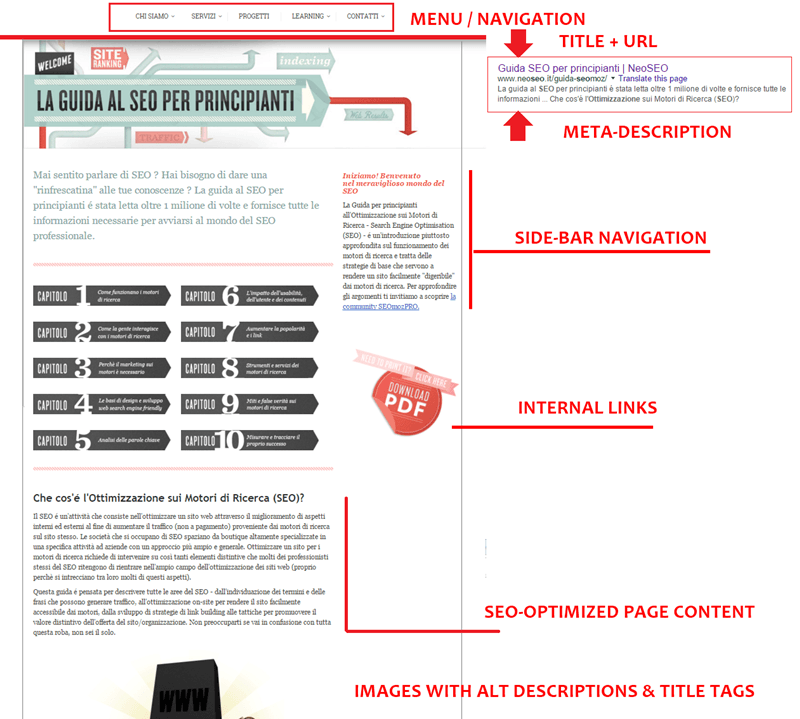
Assuming that you are already familiar with the basics of on-site SEO (if you aren’t, read this guide), I will only mention the need to use relevant keywords in your URLs, titles, headings, ALT descriptions, and page content, meta-descriptions, menu, and navigation elements.
Pro-tip: Use HTML “content-language” and “lang” meta-tags to help search engines like Bing determine what countries or languages your pages are targeting.
You should suggest relevant international versions of your site to visitors. By tracking IP addresses and browser language you can automatically suggest a relevant version of your site in a non-intrusive way.
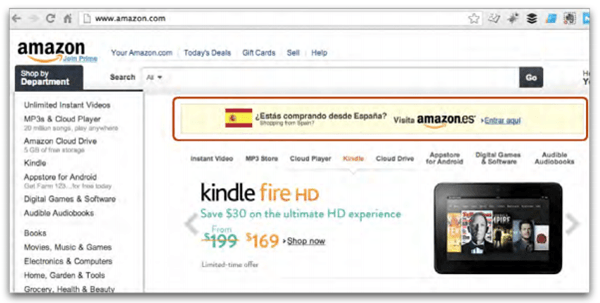
Lastly, you should ensure that all your subdomains and subdirectories are targeting the right geo-location if you aren’t using ccTLDs. You can do this from your Webmaster Tools under Search Traffic -> International Targeting (for Google).
User experience
Sorting out all of the technical components of your site is important for effective international SEO, but are you also taking a look at user experience?
The ease at which a visitor navigates your site has always been important. They won’t stick around for long if your site structure is confusing.
Google even announced a huge change to rankings based on user experience that will start taking effect in 2021. They will consider factors like mobile responsiveness, loading speed, pop-up ads, and the stability of your content on the page.
This means your UX is more important than ever, and that includes international SEO.
What can you do to improve your site’s user experience?
- Make sure your translations are in the right culture and context
- Customize online forms for international visitors
- Post video testimonials or other content with native speakers
- Allow visitors to see your prices in local currency
- List products with international measurements or sizes
- Give international visitors the choice to be redirected
At the end of the day, your goal is to design a site that is easy to navigate and makes visitors comfortable enough to purchase your products or services.
If you haven’t already, now is a good time to do a UX audit of your site.
Content marketing for international audiences
Offering content in the local language is pretty obvious for international SEO but you should also be thinking about E-A-T (Expertise, Authoritativeness, and Trustworthiness).
E-A-T is a big deal on Google but creating content with it in mind can help you stand out on any search engine. These are good principles to live by.
And on Google, they’re a ranking factor.
You need to show your international visitor that you’re an expert in your field, your authority is better than your competition’s, and ultimately they can trust you with their business.
Building trust is even more important for international SEO because visitors will be accessing your site from the other side of the world. They don’t know you or your business personally.
Here are some tips on boosting your E-A-T:
- Ask respected experts to write content for your site
- Regularly check the Google Knowledge Graph for content opportunities
- Audit your external links for quality
- Delete spammy comments on your blog posts and respond to positive ones
We don’t entirely understand how the Google algorithm works for E-A-T but we know your rankings will drop if you have low-quality content, too many advertisements, unknown authors, or no signs that you provide customer service.
These cheap ways of doing SEO won’t only negatively affect your rankings but they’ll drive customers away.
Off-site SEO (link building)
Link-building strategies for regular SEO also apply to international SEO. The only difference is that you will have to focus on a different geographical area. In other words, your goal is to obtain links from relevant ccTLDs as well as relevant languages.
Let’s say you have a Spain page on your site. What better way to prove relevance than by obtaining links from other Spanish domains? Nevertheless, you should never reject links from other gTLDs or ccTLDs in favor of 100% relevant domain extension links.
Great links will always be great links. As long as you build a healthy mix of .de’s and normal links, and vary your anchor texts, your link profile will benefit your off-site SEO efforts.
Another important thing that you need to do is to acquire links from pages that are written in the same language as your page. This will significantly boost your off-page relevance and improve geo-location for your page.
Some businesses starting with international SEO will focus all of their efforts on one language at the beginning. Then, they’ll switch to another language after about six months to a year, when they observe real results from their campaigns.
A business trying to break into international markets like Europe, for example, shouldn’t start with multiple language campaigns at once. This strategy will essentially water down their efforts.
It’s much more advantageous to rank on the first page of Google for one of the languages you’re targeting than failing to gain any traction on all of them.
International SEO link-building methods
If you’ve been in the SEO business for a while, you know all about guest posts and how they carry “link juice” to your site.
Just like the link building you’ve been doing for your business, you can write your post or hire an agency to do it for you. There are even agencies that specialize in international guest posts.
Does your target audience use Google My Business? Keeping up on this listing will boost your visibility on the search engine.
Plus international visitors will know exactly where you’re located and that helps build trust.
And besides using local citation sites like Yelp here in the United States, you can find a ton of international citation sites sorted by county.
- “whatswhat.ie” in Ireland
- “branchenbuch.meinestadt.de” in Germany
- “sg.zipleaf.com” in Singapore
- “africanadvice.com” in South Africa
- “aussieweb.com.au” in Australia
- “tuugo.fr” in France
Depending on where you’re targeting in the world, your business can be listed on some of these sites to get more localized traffic.
Another piece of advice we have is to never disregard the power of shareable content. If you have an infographic that’s getting shared a lot, consider translating it into multiple languages and seeing it that gains you some new backlinks.
Or film multiple versions of videos so you have content available in a potential customer’s native language. That would have a higher likelihood of being shared locally.
Have you ever heard of broken link campaigns? All you have to do is find other websites that have similar content to yours (probably not competitors).
If you notice they have a broken link, offer to replace it with a guest post or some of your localized content. It’s a win-win for everyone because you get a link and they remove a 404 error.
The same basics of link building apply to your international SEO. Focus on building relationships with other sites versus focusing on the transactional benefits you may receive from them.
Monitoring your Performance
Ready to start entering new markets? After you have optimized all your pages and launched the international version of your website you have to monitor performance for each language and country.
You should also keep an eye on the performance of your keywords using SemRush or Authority Labs.
Constantly check your Google Analytics to ensure that international visitors are converting according to your company’s goals.
The most important thing to keep in mind is that international SEO—like the stuff you’ve been doing—takes time. SEO in any form is a long-term strategy and it could get a year or more before you start seeing any real results.
Don’t hesitate to contact us if you need any help with your campaigns.




